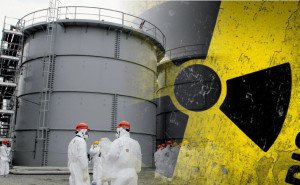Radioactive water is leaking from holding tanks at the damaged Fukushima nuclear power plant in Japan .
 Minor earlier leaks have been reported but this latest breach is believed to be the worst so far, with an estimated 300 metric tons of contaminated water escaping.
Minor earlier leaks have been reported but this latest breach is believed to be the worst so far, with an estimated 300 metric tons of contaminated water escaping.
Our colleagues at the UK SMC collected the following expert commentary. Feel free to use these quotes in your reporting.
Prof Neil Hyatt, NDA Chair in Radioactive Waste Management and Professor of Nuclear Materials Chemistry at the University of Sheffield, said:
“To keep up with the rate at which radioactive cooling water is accumulated, TEPCO [Tokyo Electric Power Company] have opted to use containment tanks incorporating plastic seals. Seepage from these joints was the cause of the latest leak of radioactive water.
“TEPCO need to develop a strategy to remove the residual contamination from this water so that it can be safely discharged under environmental regulations, and prevent it from accumulating in storage tanks. This could be achieved by further treatment using very selective ion exchange materials; these compounds take up the harmful radioactive elements from the water replacing them with non-radioactive species. This clever piece of chemistry is widely used in washing detergents, for example, where the chemical elements causing hard water are replaced with benign alternatives.”
Prof Paddy Regan, Professor of Nuclear Physics at the Un?versity of Surrey, comments:
“It is likely that the majority of the radioactivity in the contaminated water comes from two caesium isotopes: 137Cs, a fission product with a half life of 30 years; and 134Cs, a neutron-activation product and a signature of ‘spent’ reactor fuel, with a half life of about 2 years. Most of the other main volatile isotopes from the reactor products would have ‘decayed away’ by now.
“A gamma-ray spectral analysis of the water would reveal which isotopes (and how much of them) were present and therefore how dangerous the leak is. The numbers reported for dose from these concentrated sources are high – standing there for any more than a few minutes would not be encouraged – but the risks are measurable and the potential doses received should be monitored by workers in the immediate area.
“I doubt that these are having any effect at present on the radioactivity rate at the edge of the compound as they would be localised to where the leaks were. In the short term, the main radiation hazard would presumably be from external, whole body gamma-ray exposure.”
Prof Andrew Sherry, Director of the Dalton Nuclear Institute, University of Manchester, said:
“Though serious, this a long way from the Level 7 incident being faced in 2011. The approach taken by Tepco to drain the tank, pump leaked water to temporary storage, and protect the drainage of contaminated water to ground water, is entirely sensible.
“However, this incident does highlight the importance of an effective inspection programme for these many hundreds of storage tanks, and the need to consider replacing bolted or sealed storage tanks, which were relatively quick to build and were urgently needed, with a more robust welded design that has a longer design life.
“Openness and transparency of the nuclear industry was a key lesson from Fukushima and maintaining this principle during the current situation is critical. Improving public understanding of nuclear matters, including radiation, also remains a priority.”